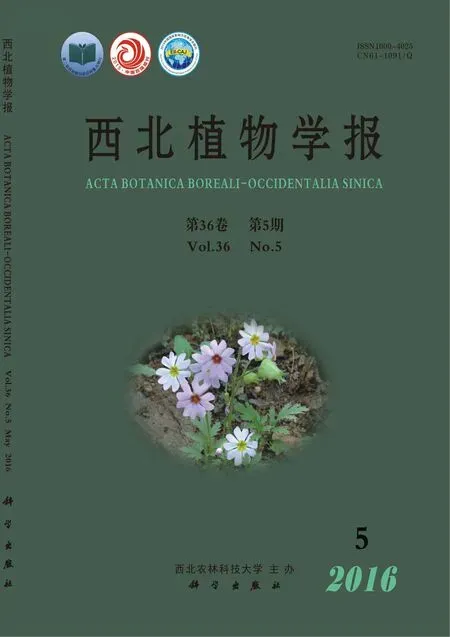增强UV-B辐射对喜树生理指标及喜树碱含量的影响
王玲丽,周晓君,刘文哲
(1 运城学院 生命科学系,山西运城 044000;2 西北大学 生命科学学院,西安 710069;3 洛阳师范学院 生命科学学院,河南洛阳 471022)
增强UV-B辐射对喜树生理指标及喜树碱含量的影响
王玲丽1,2,周晓君2,3,刘文哲2*
(1 运城学院 生命科学系,山西运城 044000;2 西北大学 生命科学学院,西安 710069;3 洛阳师范学院 生命科学学院,河南洛阳 471022)
摘要:喜树(Camptotheca acuminata Decne.)隶属于蓝果树科(Nyssaceae)喜树属(Camptotheca),为抗癌药物喜树碱的主要资源,提高喜树碱的积累以满足临床需求是喜树碱开发的重要途径。该研究运用UV-B辐射对2年生喜树进行每天8 h辐射处理,对1年生喜树分别设置每天2 h、4 h、6 h和8 h的辐射处理,连续处理12 d后分别测定各处理喜树叶的叶绿素、MDA、游离脯氨酸 (Fpro)含量和SOD活性,以及幼叶、幼枝和根中喜树碱含量,分析UV-B辐射对喜树生理指标和次生代谢物的影响,以揭示喜树碱为喜树适应UV-B辐射逆境的防御产物。结果显示:(1)2年生喜树经UV-B每天8 h辐射处理12 d后,叶绿素含量较对照显著降低,而MDA、Fpro和喜树碱含量均增加,说明每天8 h UV-B辐射对2年生喜树产生了较强的胁迫伤害。(2)1年生喜树经UV-B辐射处理12 d后,随着每天UV-B辐射时间的增加,叶绿素含量不断降低,Fpro含量显著增加;每天2~6 h处理的MDA含量与对照无显著差异,但总体随处理时间增加呈上升趋势;每天8 h UV-B辐射的MDA含量较对照显著增加;SOD活性随每天处理时间的延长呈先下降、后上升、再下降的变化趋势,说明每天8 h的UV-B辐射对一年生喜树也产生了胁迫伤害。(3)1年生喜树幼叶、幼枝和根中喜树碱含量随着每天UV-B辐射时间的延长均呈递增趋势,而且每天8 h辐射处理的喜树碱含量均最高,其中幼叶和幼枝中喜树碱含量显著高于根中含量。实验结果表明,增强UV-B辐射对喜树造成了一定的伤害,而喜树通过改变生理以及次生代谢机制,以进一步产生喜树碱来响应增强UV-B的胁迫。
关键词:喜树;UV-B辐射;喜树碱含量;生理指标
Camptotheca acuminataDecne.belongstotheNyssaceaefamilyandisaperennialdeciduousplantthatisuniquetoChina,andismainlydistributedalongtheYangtzeRiverandSouthwestprovincesofChina[1].Theplantisknowntobotanyandmedicinebecauseitsvariousorganscontainthealkaloidcamptothecin(CPT)anditsderivativeswhichhaveimportantbiologicalactivities.
CPT,apentacyclicquinolinealkaloid,isaneffectivemedicineincancertreatment,whichwasfirstisolatedfromthestemofC. acuminata,andthestructuresofthisalkaloidweredeterminedbyWallandhiscollaborators[2].CPTisknownforitsremarkableanti-canceractivitytoinhibittheeukaryoticDNAtopoisomeraseI[3].Italsoinhibitsretrovirusessuchasthehumanimmunodeficiencyvirus(HIV)andtheequineinfectiousanemiavirus[4].CPTisavaluablecompoundasachemicalprecursoroftopotecanandirinotecanwhichwereapprovedbytheUSFoodandDrugAdministrationin1996forthetreatmentofovarianandcolorectalcancers[5].
AlthoughmuchisknownaboutmanyfactorswhichaffecttheaccumulationofCPTinC. acuminata,stillonlylittleisknownabouttheeffectofUV-BradiationonCPTaccumulation.BecauseofthepromisingclinicalusesofCPT,itisimportanttoinvestigatethefactorsaffectingCPTyieldinplantmaterial.Inthepaststudy,droughtcanincreasedCPTcontentinleavesofC. acuminata[6].MethyljasmonicacidandthetreatmentsofyeastextractonleafdiscspunchedfromC. acuminataseedlingspromotedthemRNAexpressionoftryptophandecarboxylase(TDC),akeyenzymeinvolvedinCPTbiosynthesis[7].Similarly,methyljasmonicacidandyeastextracttreatmentsonC. acuminatacellsuspensionculturesincreasedCPTaccumulation[8].ItcanenhanceCPTproductionbyethanoladditioninthesuspensioncultureoftheendophyte, Fusarium solani[9].Wanget al[10]reportedCPTcontentdecreasedafter10daysUV-Bradiation,andincreasedafter40daysUV-Bradiation.ButtheydidnotstudythechangeofCPTcontentbetween10daysUV-Bradiation.ThisstudyinvestigatedtheeffectsofUV-Bradiationbetween12daysontheaccumulationofCPTinC. acuminata,whichwouldprovideabasisformaximizingCPTyieldanddesigninganaffectiveCPTproductionsystem.
1Materials and methods
1.1Plant materials
One-year-oldandtwo-year-oldC. acuminataplantsweregrownfromseeds.SeedsofC. acuminatawereselectedtogatherfromBotanicalGardenofXi’aninNovemberof2012and2013,thenrespectivelyembeddedinwetsandat25 ℃inMarchthenextyear.Aftertheseedsgeminated,theuniformseedlingswereselectedandtransplantedintoflowerpotsinthebotanicalgardenofNorthwestUniversity(Xi’an,China).
1.2UV-B radiation
SupplementalUV-BradiationwasprovidedbyfilteredGucunbrand(GucunInstrumentFactory,Shanghai,China) 30Wsunlamps.Lampsweresuspendedaboveandperpendiculartotheplantedrowsandfilteredwitheither0.13mmthickcellulosediacetate(transmissiondownto290nm)forUV-Birradianceor0.13mmpolyesterplasticfilms(absorbsallradiationbelow320nm)asacontrol.Thedesiredirradiationwasobtainedbychangingthedistancebetweenthelampsandtheplants.ThespectralirradiancefromthelampswasdeterminedwithanOptronicsModel742 (OptronicsLaboratories,Orlando,FL,USA)spectroradiometer.Thespectralirradiancewasweightedwithageneralizedplantresponsespectrumandnormalizedat300nmtoobtainthedesiredlevelofbiologicallyeffectiveUV-Bradiation.Thelampheightabovetheplantswasadjustedtomaintainadistanceof0.15mbetweenthelampsandthetopoftheplantsandprovidedsupplementalirradiancesof2.1effectiveuw·cm-2.Two-year-oldplantswereirradiatedfor12daysand8hdaily.InordertofurtherillustratetheeffectsofsupplementalUV-Birradiance,one-year-oldplantswereirradiatedfor12daysandrespectivelyarranged2h, 4h, 6hand8hradiationdaily.FilteredUV-Bradiationwasregardedasthecontrol(CK).
1.3Determination of physiological parameters
PhysiologicalparametersweredeterminatedinleavesofC. acuminata.Chlorophyllwasextractedwith96%alcohol,andchlorophyllcontentwasmeasuredaccordingtothemethodofZhang[11].Malonaldehyde(MDA)contentwasdeterminedaccordingtothemethodofHeathandPacker[12].Fprocontentwasextractedfromleavesin3%aqueoussulphosalicylicacidandestimatedusingninhydrinreagent[13].Superoxidedismutase(SOD)activitywasdeterminedaccordingtothemethodofGiannopolitisandRies[14].
1.4CPT content analysis
1.4.1HPLCanalysisTheHPLCsystemconsistedofaHPLCpump(LC-10ATvp),areversedphasecolumn(VP-ODS, 150mm×4.6mm, 5μm)andaUV-VISdetector(SPD-10Avp)forthedetectionofCPTat254nm[15].Sampleinjectionvolumewas10μLaccordingtothepresumablealkaloidcontent.Theflowratewas1.0mL·min-1.Themobilephaseusedwasmethanol/water(62/38,V/V).Columntemperaturewas25 ℃.Underthiscondition,theHPLCchromatogramsofthestandardandsamplesolutionswereshowedinFig.1.CPTstandardwaskindlysuppliedbyDr.H.BischoffofBoehringerIngelheimPharmaKG.inGermany.

Fig.1 The HPLC chromatograms of the standard and sample (peak 1: camptothecin)
1.4.2StandardcurveCPTstandard2.5mgwasputin50mLvolumetricflask,suitableamountofchromatographicmethanolwasadded,andmeteredvolumeaftertheultrasonichelpingdissolve.Thesolutionwasshakedandfilteredwith0.45μmmicroporousmembrane,then0.05mg·mL-1standardsolutionwasgot. 2, 3, 5, 8and10mLofCPTstandardsolutionwerepreciselymeasuredandputin10mLvolumetricflask,dilutedwithchromatographicmethanol,thenrespectivelymeteredvolume.ThestandardcurveforCPTwasconstructedbyseparateinjectionof10μLoftheabove-mentionedstandardsolutionaccordingtotheabovechromatographyconditions.TheregressionequationbetweenpeakareaYandtheconcentrationofcamptothecinX (μg·mL-1)was: Y=16 686X-6 577.5, R2=0.999 3.
1.4.3DeterminationofCPTcontentThesamplesweredriedintheshadeandgroundedinamortar. 100mgofthesampleswastransferredtoacentrifugetubeand4mLmethanolwasadded.Afterextractedwithsonicationfor10minatroomtemperature, 30mLwaterand40mLdichloromethanewereaddedandthiswasmixedvigorouslyfor5minonamagneticalstirrer[16],centrifugationfor10minat2 000r·min-1yieldedtwophases.ThedichloromethanephasewhichwasprovedtocontainCPT,wasrecoveredandevaporatedtodrynessinvacuumusingarotavapor.Theremainingresiduewasre-dissolvedinHPLC-grademethanol(1mL),filteredwith0.45μmmicroporousmembranethengotsamplesolutionwhichwasusedforthedeterminationofCPTcontent.Samplepeakswiththesameretentiontimetostandardswereverifiedbyspectralscananalysis.
2Results
2.1Effects of UV-B radiation on two-year-old C. acuminata
Thecontentsofchlorophyll,MDAandFproaswellasSODactivityweremeasuredaftertwo-year-oldplantswereirradiatedwithUV-Bradiation.TheresultsshowedinTable1,chlorophyllaandbcontentswerereduced,chlorophylla/bratiohadalesserextentincreaseunderenhancedUV-B.MDAandFprocontentsincreased.TheactivityofSODwasreduced.CPTcontentsinyoungleaves,youngshootsandrootofC. acuminatahadobviouslyincreasedafterUV-Btreatmentcomparedwiththecontrol,CPTcontentinroothasnosignificantdifferencecomparedwiththecontrol.
2.2UV-B radiation effects on chlorophyll contents in one-year-old C. acuminata
TheeffectsofenhancedUV-Bonchlorophyllcontentsinone-year-oldC. acuminatawereshowninFig.2.Thesametotwo-year-oldplant,chlorophyllcontentsdecreasedafterUV-Bradiation,andwiththetreatmenttimeprolonging,thechlorophyllaandchlorophyllbcontentsgraduallydecreased.Thetotalchlorophyllcontentof2h, 4h, 6hand8hUV-Btreatmentdailywasrespectivelyreducedby9.4%, 10.8%, 15.7%, 26.8%thanthecontrol.While8hUV-Btreatmentdaily,chlorophyllaandbcontentsdecreased26.4%and27.8%,respectively.Chlorophylla/bratiohadalittlechangecomparedwiththecontrol,itissuggestedthatthedifferenceofdestroyedextentaboutchlorophyllaandbisnotobvious.

Table 1 Effects of UV-B radiation on physiological indices
Note:Eachassaywasrepeatedthreetimesfromthreeindependentexperiments.Thedataarethemeans±SEMofthreereplicates.Asterisk(*)indicatesstatisticallysignificantdifference(P< 0.05;ANOVA,Tukeytest).
2.3UV-B radiation effects on MDA, Fpro contents and SOD activity in one-year-old C. acuminata


Each assay was repeated three times from three independent experiments. The data are the means ± SEM of three replicates. Different letters indicate statisticallysignificant differences (P< 0.05; ANOVA, Tukey test).The same as belowFig.2 Effect of UV-B radiation on chlorophyll content in one- year-old C. acuminata

Fig.3 Effects of UV-B radiation on MDA, Fpro contents and SOD activity in one- year-old C. acuminata

Fig.4 Effect of UV-B radiation on CPT content in one-year-old C. acuminata
2.4UV-B radiation effects on CPT contents in one-year-old C. acuminata
UV-BradiationalsohadobviouseffectsonCPTcontentsinyoungleaves,youngshootsandrootsofone-year-oldC. acuminata (Fig.4).WhenthetimeofenhancedUV-Btreatmentreachedto8hdaily,theCPTcontentsweresignificantlyincreasedcomparedwiththecontrol.WiththetimeofUV-Bradiationprolonging,CPTcontentsinyoungleavesandshootsincreasedfasterthanthatintheroot,andCPTcontentofyoungleavesincreasedto0.230%from0.106%ofthecontrolgroupafter8hradiationdaily,youngstemincreasedfrom0.064%to0.158%,andtheincreaseofCPTcontentinroothadalittlechange,increasedfrom0.036%to0.065%.
3Discussion
UV-Bradiationhasmanyeffectsonplants.AlthoughtherearesomesignificanteffectsaboutUV-Bradiationonplantgrowthanddevelopmentincertainspeciesandecosystems,itturnedoutthattheoveralldamagingeffectsofabove-ambientUV-Baremodestordifficulttodetectundernaturalconditions[17].Anexaminationofmorethan200plantspeciesrevealsthatroughly20%aresensitive, 50%aremildlysensitiveortolerantand30%arecompletelyinsensitivetoUV-Bradiation[18].UV-Bradiationactsasakindofenvironmentalstress,andtheplantwouldhavetoadapttoUV-Bradiationtominimumthedamagewhenthestresslevelreachtoalimitation.WithashortperiodofUV-BradiationinArabidopsis thalianaseedlings,rootswereelongatedandchlorophyllandsolubleproteincontentwereincreasedinleaf,butprolongedUV-Bradiationinhibitedtheelongatedrootlength,causedleafchlorophyllcontent,solubleproteincontentdecrease[19].TheeffectsofenhancedUV-Bradiationonplantphysiology,morphology,growthandbiomasshavebeeninvestigatedextensively.EnhancedUV-Bradiationmayexertanadverseinfluenceonthephysiologicalandbiochemicalprocessesofplants.Inthisstudy,wereportedtheresponsesofC. acuminataplanttoenhancedUV-Bradiation.ThisissupportedbytheearlierfindingsofintraspecificresponsesinflavonoidmetabolisminCucumis sativus[20],soybean[21]andA. thaliana[22]andinflavonoidcontentandchlorophyllcontentdecreasedinrice[23].
UV-BradiationhadobviouseffectsonchlorophyllcontentsofC. acuminata.TheUV-Bradiationmechanismofdecreasingchlorophyllcontentswasstillnotclear.ChangesinchlorophyllcontentshaveoftenbeenusedasanindextoassessthedegreesofUV-Bradiationsensitivity.Inthisstudy,chlorophyllcontentsinC. acuminataleaveswerealsosensitivetoenhancedUV-Bradiation.UV-Bradiationsignificantlydecreasedchlorophyllcontents,primarilybecauseUV-Bradiationdestroyedthestructureofthechloroplast,inhibitedthesynthesisofnewchlorophyllanddestroyedthestructureofchloroplastenvelopemembraneandincreasedthedegradationofchlorophyll.Yanget al.[24]reportedthatUV-Bradiationreducedthephotosyntheticpigmentinleaves(includingthecontentsofchlorophyllandcarotenoid,especiallythecontentofchlorophylla).ZhangindicatedthatUV-Bradiationofdifferentintensitycanmakethegrowth,chlorophyllcontentsdecreaseinVicia fabaseeding[25].TheseresultsshowedthatenhancedUV-Bradiationmadetheplantchlorophylldamage,changedtheproportionofchlorophyllaandchlorophyllb,affectedtheformationofphotosyntheticproteincomplexes,andinhibitedtheformationoforganelles.

Freeprolineaccumulationhasbeenobservedinresponsetoawiderangeofabioticandbioticstressesinplants.Prolineisconsideredtobeoneofthefirstmetabolicresponsestostress,andisperhapsasecondmessenger[29].Environmentalfactorsincludingwaterdeprivation,salinization,highandlowtemperature,heavymetaltoxicity,pathogeninfection,nutrientdeficiency,atmosphericpollutionandUV-radiationinducetheelevationoftheprolinelevelinplants.InC. acuminataplant,enhancedUV-BradiationmadeFprocontentincrease,itmaybeanadaptiveresponsetoresistUV-Bradiationstress.AnegativecorrelationbetweenSODactivityandFprocontentwasfoundunderUV-BstressconditioninC. acuminata.
MDAistheproductofmembranelipidperoxidationwhentheplanttissuesufferedoxidativestress,whichreflectsthedegreeofcellmembranelipidperoxidationandtheplanttorespondtostress.Inthispaper,MDAcontentshavenosignificantdifferencebetween6hUV-Bradiationcomparedwiththecontrol,however,MDAcontentwassignificantlyincreasedafter8hUV-Btreatment.AlowdoseofUV-BstressinducedtheproductionofacertainamountofROS,whileinherentSODinC. acuminatarapidlyeliminatedtheseROS,andresultedinthedecreaseofSODactivity.WhenthetimeofUV-Btreatmentreachedto8hdaily,alargenumberofROSweregeneratedandcausedmembranelipidperoxidation,soMDAcontentwassignificantlyincreased.Inconclusion,thereisacertaincorrelationamongthechangeofSODactivity,FprocontentandMDAcontentunderUV-Bstress,thedecreaseofSODactivityisaccompaniedbytheincreaseofMDAor/andFprocontent.
Undertheconditionofadversity,inadditiontotheplantphysiologicalindicescanbeinducedsomechanges,thesecondarymetabolismofplantwillalsobechanged.Plantsinteractwiththeirenvironmentbyproducingadiversearrayofsecondarymetabolites,oneofwhichisalkaloid.Bioticandabioticenvironmenthaveimportantrolesinthesecondarymetabolizingofplant.Asasecondarymetabolite,CPTmayplayacrucialroleduringbioticandabioticstresses,whichposeagreatimpactonalkaloidbiosynthesisandaccumulation[30].TheincreaseofalkaloidaccumulationduringseedlingsdevelopmentwasobservedandthisshowedthatCPTmayplayadefensivefunctionfortheplantsduringthisvulnerablestageoftheirlifecycle.UVlightresponsiveregionsinthepromoterofthetryptophandecarboxylase(tdc)geneinCathatranthus roseushadbeenidentified[31].Inourstudy,UV-BradiationcanobviouslyenhanceCPTcontentinC. acuminata,wehypothesizethatUV-BmightstimulatetheexpressionoftdcgeneandincreaseCPTaccumulationinC. acuminata.CPTaccumulationinducedbyUV-BradiationdemonstratedthatCPTwasinvolvedinplantdefenseagainstUV-Bradiation.WhenC. acuminatasufferedUV-Bradiationinalowdose(2h, 4h),CPTcontentwasincreasedslowly;withthetimeofUV-Bradiationincreasing(6h, 8h),CPTcontentwasincreasedrapidly,whichillustratedthatthelongtimeofUV-BradiationcausedcertaindamagetoC. acuminata,andC. acuminatadefensedprimarilybyincreasingthesecondarymetabolites-CPT.Moreover,CPTcontentsinyoungleavesandshootswereincreasedmoreobviouslythanthoseinroot,itindicatedthatenhancedUV-BradiationcouldpriorityimproveCPTaccumulationofaerialorganinC. acuminata,becauseaerialorganmainlysufferedUV-Bstress.
EnhancedUV-BradiationcausedcertaindamagetoC. acuminata,notonlyaffectsthemorphologyofC. acuminata[10],butalsoaffectsthephysiologicalandbiochemicalmetabolism.UnderthestressofUV-B, C. acuminataitselfdefensedthisstressbychangingphysiologicalindices(i.e.,SODactivity,MDAandFprocontent)andsecondarymetabolismtoaccumulateCPT.Therefore,thechangesofphysiologicalindicesandCPTaccumulationarealsotheadaptivemechanismtoresponsetothestressofenhancedUV-BradiationinC. acuminata.Furthermore,intheindustryplantingofC. acuminata,themethodofsupplementing8hUV-BradiationdailytopromotetheincreaseofCPTcontentisfeasible.
References:
[1]中国科学院中国植物编辑委员会,中国植物志[M].北京:科学出版社,1983.52(2):144-147.
[2]WALLME,WANIMC,COOKECE, et al.Plantantitumoragents,theisolationandstructureofcamptothecin,anovelalkaliodalleukaemiaandtumorinhibitorfromCamptotheca acuminata [J]. Journal of American Chemical Society, 1966, 88(16): 3 888-3 890.
[3]KJELDSENE,SVEJSTRUPJQ,GROMOVAII, et al.CamptothecininhibitsboththecleavageandrelegationreactionsofeukaryoticDNAtopoisomeraseI[J]. Journal of Molecular Biology, 1992, 228(4): 1 025-1 030.
[4]PRIELE,SHOWWALTERSD,ROBERTSM, et al.ThetopoisomeraseIinhibitor,camptothecin,inhibitsequineinfectionsanemiavirusreplicationinchronicallyinfectedCF2Thcells[J]. Journal of Virology, 1991, 65(8): 4 137-4 141.
[5]GREEMERSJP,DESPASR,FAVALLIG, et al.Topotecan,anactivedruginthesecond-linetreatmentofepithelialovariancancer:resultsofalargeEuropeanphaseIIstudy[J]. Journal of Clinical Oncology, 1996, 14(12): 3 056-3 061.
[6]LIUZJ.Drought-inducedinvivosynthesisofcamptothecininCamptotheca acuminataseedlings[J]. Physiologia Plantarum, 2000, 110(4): 483-488.
[7]LPEZ-MEYERM,NESSLERCL.TryptophandecarboxylaseisencodedbytwoantonomouslyregulatedgenesinCamptotheca acuminatawhicharedifferentiallyexpressedduringdevelopmentandstress[J]. The Plant Journal, 1997, 11(6): 1 167-1 175.
[8]SONGSH,BYUNSY.CharacterizationofcellgrowthandcamptothecinproductionincellculturesofCamptotheca acuminata[J]. Journal of Microbiology and Biotechnology, 1998, 8(6): 631-638.
[9]VENUGOPALANA,SRIVASTAVAS.Enhancedcamptothecinproductionbyethanoladditioninthesuspensioncultureoftheendophyte, Fusarium solani [J]. Bioresource Technology, 2015, 188: 251-257.
[10]王海霞,刘文哲.增强UV-B辐射对喜树幼苗生物量和两种生物碱含量的影响[J].植物科学学报,2011, 29(6): 712-717.
WANGHX,LIUWZ,EffectsofenhancedUV-Bradiationonbiomassandcontentsofcamptothecinand10-hydroxy-camptothecininCamptotheca acuminata [J]. Plant Science Journal, 2011, 29(6): 712-717.
[11]张振清.植物生理学实验手册[M].上海:上海科学技术出版社, 1985: 134-135.
[12]HEATHRI,PACKERL.Photoperoxidationinisolatedchloroplasts:I.Kineticsandstoichiometryoffattyacidperoxidation[J]. Archives of Biochemistry and Biophysics, 1968, 125(1): 189-198.
[13]BATESLS,WALDRONRP,TEAREID.Rapiddeterminationoffreeprolineforwater-stressstudies[J]. Plant and Soil, 1973, 39(1): 205-208.
[14]GIANNOPOLITISCN,RIESSK.Superoxidedismutases.I.Purificationandquantitativerelationshipwithwater-solubleproteininseedlings[J]. Plant Physiology, 1977, 59(2): 315-318.
[15]王玲丽.喜树营养器官的结构及喜树碱含量动态变化的研究[D].西安:西北大学,2006.
[16]VANHENGELAJ,HARKESMP,WICHERSHJ, et al.CharacterizationofcallusformationandcamptothecinproductionbycelllinesofCamptotheca acuminata[J]. Plant Cell, Tissure and.Organ Culture, 1992, 28(1): 11-18.
[17]SEARLESPS,FLINTSD,CALDWELLMM.Ameta-analysisofplantfieldstudiessimulatingstratosphericozonedepletion[J]. Oecologia, 2001, 127(1): 1-10.
[18]TERAMURAAH.Effectsofultraviolet-Bradiationonthegrowthandyieldofcropplants[J]. Physiologia Plantarum, 1983, 58(3): 415-427.
[19]HANW,HANR.EffectofdifferenttimesofUV-BradiationonseedlinggrowthofArabidopsis thaliana[J]. Chinese Bulletin of Botany, 2015, 50(1): 40-46.
[20]MURALINS,TERAMURAAH.IntraspecificdifferencesinCucumis sativussensitivitytoultraviolet-Bradiation[J]. Physiologia Plantarum, 1986, 68(4): 673-677.
[21]D’SURNEYSJ,TSCHAPLINSKITJ,EDWARDSNT, et al.BiologicalresponsesoftwosoybeancultivarsexposedtoenhancedUV-Bradiation[J]. Environmental and Experimental Botany, 1993, 33(3): 347-356.
[22]FISCUSEL,PHILBECKR, et al.GrowthofArabidopsisflavonoidmutantsundersolarradiationandUVfilters[J]. Environmental and Experiment Botany, 1999, 41(3): 231-245.
[23]TERAMURAAH,ZISKALH,SZTEINAE.ChangesingrowthandphotosyntheticcapacityofricewithincreasedUV-Bradiation[J]. Physiologia Plantarum, 1991, 83(3): 373-380.
[24]杨景宏,陈拓,王勋陵.增强UV-B辐射对小麦叶片内源ABA和游离脯氨酸的影响[J]. 生态学报, 2000, 20(1): 39-42.
YANGJH,CHENT,WANGXL.EffectofenhancedUV-BradiationonendogenousABAandfreeprolinecontentsinwheatleaves[J]. Acta Ecologica Sinica, 2000, 20(1): 39-42.
[25]张红霞,吴能表,胡丽涛,等.不同强度UV-B辐射胁迫对蚕豆幼苗生长及叶绿素荧光特性的影响[J]. 西南师范大学学报(自然科学版),2010, 35(1): 105-110.
ZHANGHX,WUNB,HULT, et al.TheeffectsofdifferenttreatmentswithUV-BradiationstressonseedlinggrowthandcharacterofchlorophyllfluorescenceofVicia fabaL..[J]. Journal of Southwest China Normal University (NaturalScienceEdition), 2010, 35(1): 105-110.
[26]冯建灿,张玉洁,杨天柱.低温胁迫对喜树幼苗SOD活性、MDA和脯氨酸含量的影响[J].林业科学研究,2002, 15(2):197-202.
FENGJC,ZHANGYJ,YANGTZ.Effectoflowtemperaturestressonthemembrane-lipidperoxidationandtheconcentrationoffreeprolineinCamptotheca acuminataseedling[J]. Forest Research, 2002, 15(2):197-202.
[27]陈拓,任红旭,王勋陵.UV-B辐射对小麦叶抗氧化系统的影响[J]. 环境科学学报,1999, 19(4):453-455.
CHENT,RENHX,WANGXL.InfluenceofenhancedUV-Bradiationonantioxidantsystemsinwheatleaves[J]. Acta Scientiae Circumstantiae, 1999, 19(4): 453-455.
[28]冯国宁,安黎哲,冯虎元,等.增强UV-B辐射对菜豆蛋白质代谢的影响[J].植物学报,1999, 41(8): 833-836.
FENGGN,ANLZ,FENGHY, et al.EffectsofenhancedUV-Bradiationonproteinmetabolismofbeanleaves[J]. Acta Botanica Sinica, 1999, 41(8): 833-836.
[29]HAREPD,CRESSWA,Metabolicimplicationsofstress-inducedprolineaccumulationinplants[J]. Plant Growth Regulation, 1997, 21(2): 79-102.
[30]祖元刚,唐中华,于景华,等.喜树幼苗中喜树碱和10-羟基喜树碱对热激的响应特点和意义[J]. 植物学报,2003, 45(7): 809-814.
ZUYG,TANGZH,YUJH, et al.Differentresponsesofcamptothecinand10-hydroxy-camptothecintoheatshockinCamptotheca acuminataseedlings[J]. Acta Botanica Sinica, 2003, 45(7): 809-814.
[31]OUWERKERKPBF,HALLARDD,VERPOORTER, et al.IdentificationofUV-Blight-responsiveregionsinthepromoterofthetryptophandecarboxylasegenefromCatharanthus roseus[J]. Plant Molecular Biology,1999, 41(4): 491-503.
(编辑:潘新社)
EffectsofEnhancedUltraviolet-BRadiationonPhysiologicalIndicesandCamptothecinContentinCamptotheca acuminataDecne
WANGLingli1,2,ZHOUXiaojun2,3,LIUWenzhe2*
(1DepartmentofLifeScience,YunchengUniversity,Yuncheng,Shanxi044000,China; 2CollegeofLifeScience,NorthwestUniversity,Xi’an, 710069,China;3SchoolofLifeSciences,LuoyangNormalUniversity,Luoyang,He’nan471022,China)
Abstract:Camptotheca acuminata Decne. (Nyssaceae) is a major source of anticancer camptothecin (CPT). It is imperative to induce CPT accumulation in order to develop CPT production strategies to satisfy clinical uses of CPT. In this study, two-year-old C. acuminata were dealt 8 h each day with UV-B radiation for 12 days, and one-year-old C. acuminata were respectively arranged to radiate 2 h,4 h,6 h and 8 h with UV-B radiation each day for 12 days. The contents of chlorophyll, MDA and free proline (Fpro), the activity of SOD in leaf and CPT content in young leaves, young shoots and root were separately measured after UV-B treatment. In order to reveal that camptothecin is the defense product of UV-B stress, the effects of UV-B radiation on the physiological indices and secondary metabolites were analyzed. The results showed that: (1) in two-year-old C. acuminata, chlorophyll content was significantly decreased, MDA, Fpro and CPT contents were significantly increased after 8 h UV-B treatment daily. It indicated that 8 h UV-B radiation caused great stress influences on two-year-old C. acuminata. (2) In one-year-old C. acuminata, with the time of UV-B radiation increasing, chlorophyll content was gradually decreased; Fpro content was significantly increased; MDA content had no significantly difference between 2 h and 6 h UV-B radiation, but significantly increased after 8 h radiation compared with the control; SOD activity decreased firstly, then increased, lastly decreased with the time of UV-B radiation prolonging every day. It showed that 8 h UV-B radiation also caused stress influences on one-year-old C. acuminata. (3) CPT contents in vegetative organs of one-year-old C. acuminata were gradually increased with the time of UV-B radiation prolonging, and the contents were the highest after 8 h UV-B radiation each day. Moreover, CPT content increased more obviously in young leaves and young shoots than those in roots. It confirmed that enhanced UV-B radiation caused certain damage to C. acuminata, and C. acuminata responded to this stress by not only changing physiological indices, but also changing secondary metabolism to accumulate CPT.
Key words:Camptotheca acuminata; ultraviolet-B (UV-B) radiation; camptothecin (CPT) content; physiological index
文章编号:1000-4025(2016)05-0979-08
doi:10.7606/j.issn.1000-4025.2016.05.0979
收稿日期:2015-10-12;修改稿收到日期:2016-03-28
基金项目:国家自然科学基金(31270428)
作者简介:王玲丽(1980-),女,在读博士研究生,讲师,主要从事结构植物学研究。 E-mail:wanglingli_521@163.com *通信作者:刘文哲,教授,博士生导师,主要从事结构植物学与繁殖生态学研究。E-mail: lwenzhe@nwu. edu.cn
中图分类号:Q945.79;
文献标志码:A

